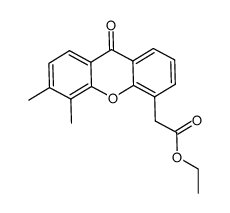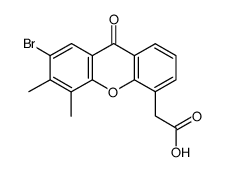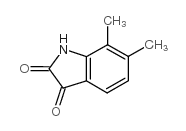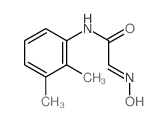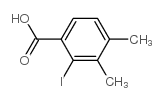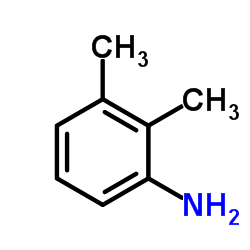117570-53-3
| Name | vadimezan |
|---|---|
| Synonyms |
5,6-Dimethyl-9-oxo-9H-xanthene-4-acetic acid
5,6-dimethylxanthenoneacetic acid (5,6-Dimethyl-9-oxo-9H-xanthen-4-yl)acetic acid Vadimezan 2-(5,6-Dimethyl-9-oxo-9H-xanthen-4-yl)acetic acid 9H-Xanthene-4-acetic acid, 5,6-dimethyl-9-oxo- T C666 BO IVJ D1 E1 N1VQ ASA-404 DMXAA 5,6-Dimethylxanthenone-4-acetic acid |
| Description | Vadimezan (ASA-404; DMXAA), the vascular disrupting agent, is a murine agonist of the stimulator of interferon genes (STING) and also a potent inducer of type I IFNs and other cytokines. |
|---|---|
| Related Catalog | |
| Target |
STING[1], type I IFNs[2] |
| In Vitro | Vadimezan (DMXAA), the vascular disrupting agent, is a murine agonist of the stimulator of interferon genes (STING) and also a potent inducer of type I IFNs and other cytokines. Vadimezan (DMXAA) has no detrimental effect on 344SQ-ELuc cell viability. It is found that Vadimezan-mediated up regulation of the NF-κB pathway as shown by increased p65 phosphorylation in M2 macrophages[1]. Results demonstrate that Vadimezan (DMXAA)-treated cells are protected from VSV-induced cytotoxicity at all MOIs in contrast to medium-pretreated macrophages. Vadimezan (DMXAA) effectively inhibits growth of both strains of influenza, demonstrating the potential of Vadimezan for treatment of drug-resistant strains of human influenza[2]. |
| In Vivo | 344SQ-ELuc NSCLC subcutaneous tumors respond dramatically to Vadimezan (DMXAA), with a marked decrease in bioluminescence (BLI) signals post-drug injection. Vadimezan (DMXAA) treatment of 344SQ-ELuc metastases yields no decrease in photon emission rates, with the tumors remaining histologically similar to controls after this treatment. As with the large subcutaneous tumors, Vadimezan (DMXAA) administration to mice with small subcutaneous tumors still leads to ~2-log decreases in photon emission at both 6 and 24 hours[1]. In vivo, Vadimezan (DMXAA) is a more potent inducer of IFN-β mRNA and a relatively poor inducer of TNF-α mRNA. Vadimezan (DMXAA) administration leads to significantly less weight loss in influenza-infected mice[2]. |
| Kinase Assay | M2-polarized macrophages are treated with 20 µg/mL Vadimezan (ASA-404) or DMSO vehicle for 30 min. Cells are then lysed and protein denatured in SDS buffer and samples sent for RPPA analysis. Differential abundance of various proteins and/or their phosphorylation status in response to Vadimezan (ASA-404) is assessed[1]. |
| Cell Assay | RAW 264.7 macrophages are cultured and plated at 1×105 cells/well in a 96-well plate. After overnight incubation at 37°C, cells are treated with medium containing vehicle or Vadimezan (DMXAA) (100 μg/mL). After 6 h, the culture medium is replaced with serum-free DMEM containing VSV at the indicated MOI for 1 h. Cells are then maintained in complete DMEM with 10% FBS. Twenty-four hours later, cells are washed with PBS, fixed with 10% buffered formalin, and rinsed thoroughly with distilled water. Adherent cells are stained with crystal violet[2]. |
| Animal Admin | Male 129/Sv mice (6 to 12 week old) are used in this study. To generate subcutaneous tumors, 5×105 344SQ-ELuc cells in 100 µL PBS are injected in both posterior flanks of mice. Tumor growth is monitored every 2 to 4 days via BLI. Once tumors are established (day 10 for systemic metastases; day 7 or day 14 for subcutaneous tumors), mice are given 25 mg/kg of Vadimezan (DMXAA), or DMSO vehicle by i.p. injection. BLI is carried out at 6 and 24 hours [1]. |
| References |
| Density | 1.3±0.1 g/cm3 |
|---|---|
| Boiling Point | 520.9±50.0 °C at 760 mmHg |
| Melting Point | 264 °C |
| Molecular Formula | C17H14O4 |
| Molecular Weight | 282.291 |
| Flash Point | 197.1±23.6 °C |
| Exact Mass | 282.089203 |
| PSA | 67.51000 |
| LogP | 3.60 |
| Appearance | solid | light brown |
| Vapour Pressure | 0.0±1.4 mmHg at 25°C |
| Index of Refraction | 1.633 |
| Storage condition | 2-8°C |
| Water Solubility | DMSO: 17 mg/mL, soluble |
|
Section1. IDENTIFICATION OF THE SUBSTANCE/MIXTURE Product identifiers Product name: DMXAA CAS-No.: 117570-53-3 Relevant identified uses of the substance or mixture and uses advised against Identified uses: Laboratory chemicals, Manufacture of substances Section2. HAZARDS IDENTIFICATION Classification of the substance or mixture Classification according to Regulation (EC) No 1272/2008 [EU-GHS/CLP] Acute toxicity, Oral (Category 4) Acute aquatic toxicity (Category 1) Classification according to EU Directives 67/548/EEC or 1999/45/EC Harmful if swallowed. Very toxic to aquatic organisms, may cause long-term adverse effects in the aquatic environment. Label elements Labelling according Regulation (EC) No 1272/2008 [CLP] Pictogram Signal wordWarning Hazard statement(s) H302Harmful if swallowed. H400Very toxic to aquatic life. Precautionary statement(s) P273Avoid release to the environment. Supplemental Hazardnone Statements According to European Directive 67/548/EEC as amended. Hazard symbol(s) R-phrase(s) R22Harmful if swallowed. R50/53Very toxic to aquatic organisms, may cause long-term adverse effects in the aquatic environment. S-phrase(s) S60This material and its container must be disposed of as hazardous waste. S61Avoid release to the environment. Refer to special instructions/ Safety data sheets. Other hazards - none Section3. COMPOSITION/INFORMATION ON INGREDIENTS Substances Synonyms: 5,6-Dimethylxanthenone-4-acetic Acid Formula: C17H14O4 C17H14O4 Molecular Weight: 282,29 g/mol ComponentConcentration 5,6-Dimethyl-9-oxo-9H-xanthene-4-acetic acid CAS-No.117570-53-3- Section4. FIRST AID MEASURES Description of first aid measures General advice Consult a physician. Show this safety data sheet to the doctor in attendance. If inhaled If breathed in, move person into fresh air. If not breathing, give artificial respiration. Consult a physician. In case of skin contact Wash off with soap and plenty of water. Consult a physician. In case of eye contact Flush eyes with water as a precaution. If swallowed Never give anything by mouth to an unconscious person. Rinse mouth with water. Consult a physician. Most important symptoms and effects, both acute and delayed To the best of our knowledge, the chemical, physical, and toxicological properties have not been thoroughly investigated. Indication of any immediate medical attention and special treatment needed no data available Section5. FIREFIGHTING MEASURES Extinguishing media Suitable extinguishing media Use water spray, alcohol-resistant foam, dry chemical or carbon dioxide. Special hazards arising from the substance or mixture Carbon oxides Advice for firefighters Wear self contained breathing apparatus for fire fighting if necessary. Further information no data available Section6. ACCIDENTAL RELEASE MEASURES Personal precautions, protective equipment and emergency procedures Use personal protective equipment. Avoid dust formation. Avoid breathing vapors, mist or gas. Ensure adequate ventilation. Evacuate personnel to safe areas. Avoid breathing dust. Environmental precautions Prevent further leakage or spillage if safe to do so. Do not let product enter drains. Discharge into the environment must be avoided. Methods and materials for containment and cleaning up Pick up and arrange disposal without creating dust. Sweep up and shovel. Keep in suitable, closed containers for disposal. Reference to other sections For disposal see section 13. Section7. HANDLING AND STORAGE Precautions for safe handling Avoid contact with skin and eyes. Avoid formation of dust and aerosols. Provide appropriate exhaust ventilation at places where dust is formed.Normal measures for preventive fire protection. Conditions for safe storage, including any incompatibilities Store in cool place. Keep container tightly closed in a dry and well-ventilated place. Recommended storage temperature: 2 - 8 °C Specific end uses no data available Section8. EXPOSURE CONTROLS/PERSONAL PROTECTION Control parameters Components with workplace control parameters Exposure controls Appropriate engineering controls Handle in accordance with good industrial hygiene and safety practice. Wash hands before breaks and at the end of workday. Personal protective equipment Eye/face protection Safety glasses with side-shields conforming to EN166 Use equipment for eye protection tested and approved under appropriate government standards such as NIOSH (US) or EN 166(EU). Skin protection Handle with gloves. Gloves must be inspected prior to use. Use proper glove removal technique (without touching glove's outer surface) to avoid skin contact with this product. Dispose of contaminated gloves after use in accordance with applicable laws and good laboratory practices. Wash and dry hands. The selected protective gloves have to satisfy the specifications of EU Directive 89/686/EEC and the standard EN 374 derived from it. Body Protection Complete suit protecting against chemicals, The type of protective equipment must be selected according to the concentration and amount of the dangerous substance at the specific workplace. Respiratory protection For nuisance exposures use type P95 (US) or type P1 (EU EN 143) particle respirator.For higher level protection use type OV/AG/P99 (US) or type ABEK-P2 (EU EN 143) respirator cartridges. Use respirators and components tested and approved under appropriate government standards such as NIOSH (US) or CEN (EU). Section9. PHYSICAL AND CHEMICAL PROPERTIES Information on basic physical and chemical properties a) AppearanceForm: solid b) Odourno data available c) Odour Thresholdno data available d) pHno data available e) Melting point/freezingno data available point f) Initial boiling point and no data available boiling range g) Flash pointno data available h) Evaporation rateno data available i) Flammability (solid, gas) no data available j) Upper/lowerno data available flammability or explosive limits k) Vapour pressureno data available l) Vapour densityno data available m) Relative densityno data available n) Water solubilityno data available o) Partition coefficient: n- log Pow: 3,207 octanol/water p) Autoignitionno data available temperature q) Decompositionno data available temperature r) Viscosityno data available s) Explosive propertiesno data available t) Oxidizing propertiesno data available Other safety information no data available Section10. STABILITY AND REACTIVITY Reactivity no data available Chemical stability no data available Possibility of hazardous reactions no data available Conditions to avoid no data available Incompatible materials Strong oxidizing agents Hazardous decomposition products Other decomposition products - no data available Section11. TOXICOLOGICAL INFORMATION Information on toxicological effects Acute toxicity no data available Skin corrosion/irritation no data available Serious eye damage/eye irritation no data available Respiratory or skin sensitization no data available Germ cell mutagenicity no data available Carcinogenicity IARC:No component of this product present at levels greater than or equal to 0.1% is identified as probable, possible or confirmed human carcinogen by IARC. Reproductive toxicity no data available Specific target organ toxicity - single exposure no data available Specific target organ toxicity - repeated exposure no data available Aspiration hazard no data available Potential health effects InhalationMay be harmful if inhaled. May cause respiratory tract irritation. IngestionHarmful if swallowed. SkinMay be harmful if absorbed through skin. May cause skin irritation. EyesMay cause eye irritation. Signs and Symptoms of Exposure To the best of our knowledge, the chemical, physical, and toxicological properties have not been thoroughly investigated. Additional Information RTECS: ZD5536200 Section12. ECOLOGICAL INFORMATION Toxicity no data available Persistence and degradability no data available Bioaccumulative potential no data available Mobility in soil no data available Results of PBT and vPvB assessment no data available Other adverse effects Very toxic to aquatic life. no data available Section13. DISPOSAL CONSIDERATIONS Waste treatment methods Product Offer surplus and non-recyclable solutions to a licensed disposal company. Contact a licensed professional waste disposal service to dispose of this material. Dissolve or mix the material with a combustible solvent and burn in a chemical incinerator equipped with an afterburner and scrubber. Contaminated packaging Dispose of as unused product. Section14. TRANSPORT INFORMATION UN number ADR/RID: 3077IMDG: 3077IATA: 3077 UN proper shipping name ADR/RID: ENVIRONMENTALLY HAZARDOUS SUBSTANCE, SOLID, N.O.S. (5,6-Dimethyl-9-oxo-9H- xanthene-4-acetic acid) IMDG: ENVIRONMENTALLY HAZARDOUS SUBSTANCE, SOLID, N.O.S. (5,6-Dimethyl-9-oxo-9H- xanthene-4-acetic acid) IATA:Environmentally hazardous substance, solid, n.o.s. (5,6-Dimethyl-9-oxo-9H-xanthene-4-acetic acid) Transport hazard class(es) ADR/RID: 9IMDG: 9IATA: 9 Packaging group ADR/RID: IIIIMDG: IIIIATA: III Environmental hazards ADR/RID: yesIMDG Marine pollutant: yesIATA: yes Special precautions for user Further information EHS-Mark required (ADR 2.2.9.1.10, IMDG code 2.10.3) for single packagings and combination packagings containing inner packagings with Dangerous Goods > 5L for liquids or > 5kg for solids. Section15. REGULATORY INFORMATION This safety datasheet complies with the requirements of Regulation (EC) No. 1907/2006. Safety, health and environmental regulations/legislation specific for the substance or mixture no data available Chemical Safety Assessment no data available Section16. OTHER INFORMATION Further information Copyright 2012 Co. LLC. License granted to make unlimited paper copies for internal use only. The above information is believed to be correct but does not purport to be all inclusive and shall be used only as a guide. The information in this document is based on the present state of our knowledge and is applicable to the product with regard to appropriate safety precautions. It does not represent any guarantee of the properties of the product. Corporation and its Affiliates shall not be held liable for any damage resulting from handling or from contact with the above product. See and/or the reverse side of invoice or packing slip for additional terms and conditions of sale. |
| Symbol |


GHS07, GHS09 |
|---|---|
| Signal Word | Warning |
| Hazard Statements | H302-H400 |
| Precautionary Statements | P273 |
| Personal Protective Equipment | dust mask type N95 (US);Eyeshields;Faceshields;Gloves |
| Hazard Codes | Xn: Harmful;N: Dangerous for the environment; |
| Risk Phrases | R22;R50/53 |
| Safety Phrases | 60-61 |
| RIDADR | UN 3077 |
| WGK Germany | 3 |
| RTECS | ZD5536200 |
| HS Code | 2932999099 |
|
~% 
117570-53-3 |
| Literature: US2010/99754 A1, ; Page/Page column 7 ; |
|
~95% 
117570-53-3 |
| Literature: Yang, Shangjin; Denny, William A. Tetrahedron Letters, 2009 , vol. 50, # 27 p. 3945 - 3947 |
|
~10% 
117570-53-3 |
| Literature: Yang, Shangjin; Denny, William A. Tetrahedron Letters, 2009 , vol. 50, # 27 p. 3945 - 3947 |
|
~% 
117570-53-3 |
| Literature: Journal of Medicinal Chemistry, , vol. 34, # 1 p. 217 - 222 |
|
~% 
117570-53-3 |
| Literature: Journal of Medicinal Chemistry, , vol. 34, # 1 p. 217 - 222 |
|
~% 
117570-53-3 |
| Literature: Journal of Medicinal Chemistry, , vol. 34, # 1 p. 217 - 222 |
|
~% 
117570-53-3 |
| Literature: Journal of Medicinal Chemistry, , vol. 34, # 1 p. 217 - 222 |
|
~% 
117570-53-3 |
| Literature: Journal of Medicinal Chemistry, , vol. 34, # 1 p. 217 - 222 |
|
~% 
117570-53-3 |
| Literature: European Journal of Medicinal Chemistry, , vol. 37, # 10 p. 825 - 828 |
| Precursor 6 | |
|---|---|
| DownStream 0 | |
| HS Code | 2932999099 |
|---|---|
| Summary | 2932999099. other heterocyclic compounds with oxygen hetero-atom(s) only. VAT:17.0%. Tax rebate rate:13.0%. . MFN tariff:6.5%. General tariff:20.0% |


